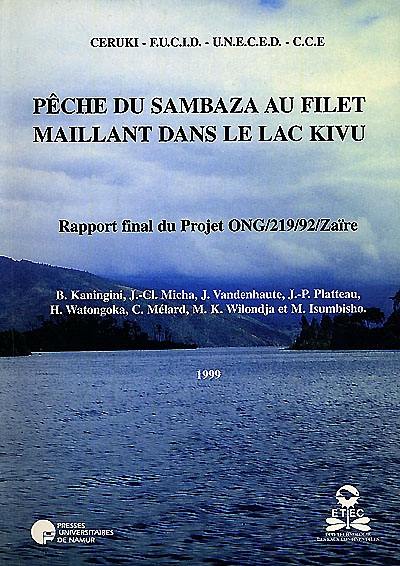
Fiche technique
Format : Broché
Nb de pages : 187 pages
Poids : 500 g
Dimensions : 21cm X 30cm
EAN : 9782870372876
Pêche du Sambaza au filet maillant dans le lac Kivu
rapport final du projet ONG-219-92-Zaïre, 1999
Quatrième de couverture
L'unité d'Ecologie des eaux douces suit depuis pratiquement 23 ans la problématique du lac Kivu. Lac de barrage volcanique âgé d'environ 16000 ans, profond de 485 m et à stratification presque permanenté avec un gisement de méthane considérable dans la strate anaérobique profonde. Seuls les 70 premiers mètres à partir de la surface sont habités par des organismes aérobies.
L'introduction rationnelle et réussie d'un clupéide endémique du lac Tanganyika en 1959-1960 permit une augmentation de la production annuelle de poissons du lac de plusieurs milliers de tonnes.
En 1978, le gouvernement rwandais en collaboration avec le PNUD et la FAO ont démarré les activités de pêche artisanale au carrelet dans la partie rwandaise du lac Kivu.
De 1987 à 1992, B. Kaningini, biologiste de l'Institut Supérieur Pédagogique de Bukavu (Kivu, RD Congo) a réalisé une recherche doctorale sur la biologie et l'exploitation de L. miodon. L'étude comparée de deux techniques de pêche, pêche au carrelet par attraction lumineuse introduite au lac Kivu par la FAO et la pêche expérimentale au filet maillant introduite par l'Unité d'Ecologie des Eaux Douces des Facultés Universitaires Notre dame de la Paix de Namur (Belgique) a été menée.
De 1993 à juin 1999, grâce à un cofinancement de la Commission de l'Union Européenne, de la Fondation Universitaire pour la Coopération Internationale au Développement des Facultés Universitaires Notre-dame de la paix et du Centre de Recherches Universitaires du Kivu, le développement de la pêche au filet maillant a été mené par 200 pêcheurs volontaires qui ont reçu le soutien logistique sous forme de crédit filet remboursé entièrement en 5 - 6 mois. Cette démarche de recherche et développement menée conjointement par les pêcheurs et les chercheurs en interaction continue semble conduire à un véritable développement durable, source de revenus adéquats pour les populations riveraines.
For pratically 23 years the fresh water Ecology unit has been studying the problems relating to Lake Kivu. The lake was formed by volcanic action around 16.000 years ago, has a depth of 485 metres and a stratification that is almost permanent with a considerable deposit of methane in the deep anaerobic stratum. Only the first 70 metres below the surface are inhabited by aerobic organisms.
The planned and successful introduction of an endemic clupeid from Lake Tanganyika in 1959-1960 resulted in an increase in the annual fish production of the lake of several thousand tons.
In 1978, the Ruandan government, in collaboration with the PNUD and the FAO, started craft fishing activities using square fishing nets in the Ruandan part of Lake Kivu.
From 1987 to 1992, B. Kaningini, a biologist from the Higher Pedagogical Institute of Bukavu (Kivu, RD Congo) carried out his doctoral research on the biology and the exploitation of L. miodon. The comparative study of two fishing techniques, square net fishing by light attraction introduced into the lake by the FAO and experimental mesh net fishing introduced by the fresh water Ecology unit of Namur University (Facultés Universitaires Notre-Dame de la Paix, Belgium) was carried out.
From 1993 to June 1999, thanks to cofinancing by the Commission of the European Union, the University Foundation for International Cooperation in Development at Namur University and the Centre of University Research in Kivu, the development of net fishing was carried out by 200 voluntary fishermen who received support in the form of credit to purchase the nets that was fully reimbursed in 5 to 6 months.
This research and development initiative carried out by the fishermen and researchers working together still seems to be leading to real and lasting develoment, constituting and adequate source of income for the people living on the banks of the lake.
Fish managers, development organizations, teachers, lake-side dwellers can all find in this document information useful for a sound knowledge and good ecological management of Lake Kivu as well as a planned and sustainable exploitation of its fish stock.





